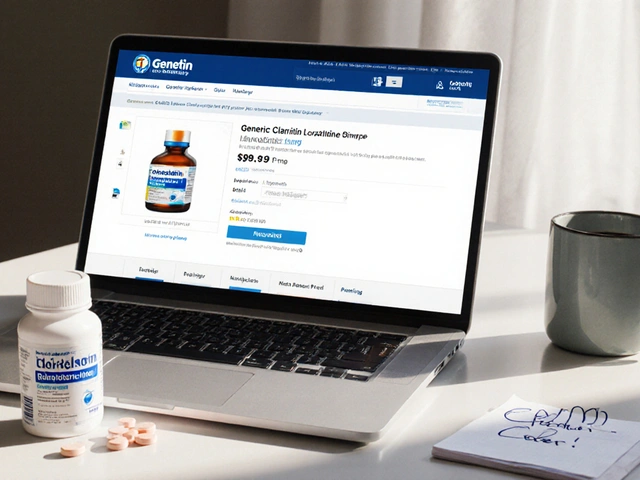Laxative Selection Guide
Choose Your Situation
Recommended Options
Key Considerations
When you’re battling stubborn constipation, the first question is usually “which laxative actually works for me?” Duphalac is the brand name for lactulose, a synthetic sugar that draws water into the colon and softens stool. It’s been a go‑to prescription in Australia for decades, but a growing menu of over‑the‑counter (OTC) options means you have more choices than ever.
Key Takeaways
- Duphalac works by changing the osmotic balance in the gut; it’s ideal for chronic constipation and hepatic encephalopathy.
- OTC options such as polyethylene glycol (Miralax) and magnesium‑based laxatives act faster but may cause electrolyte shifts.
- Stimulant laxatives (senna, bisacodyl) are best for occasional relief, not long‑term use.
- Fiber supplements address diet‑related constipation and can be combined with osmotic agents.
- Safety, drug interactions, and personal health conditions dictate the best choice.
How Duphalac (Lactulose) Works
Lactulose is a disaccharide composed of galactose and fructose. It’s not absorbed in the small intestine, so it reaches the colon intact. Once there, gut bacteria ferment it into short‑chain fatty acids, pulling water into the lumen and softening the stool. This osmotic effect also lowers colonic pH, which helps trap ammonia in patients with liver disease.
Typical dosing in Australia starts at 15‑30 mL once daily for chronic constipation, adjustable up to 60 mL. It may take 24‑48 hours to notice a change, which feels slower than some OTC products but offers a gentler, longer‑lasting effect.
When Duphalac Is the Right Pick
Duphalac shines in two main scenarios:
- Chronic constipation where daily dosing is needed without the risk of habit‑forming stimulant laxatives.
- Hepatic encephalopathy management, because the same osmotic action traps ammonia.
Because it’s a prescription medication in Australia, you’ll need a doctor’s approval. The Therapeutic Goods Administration (TGA) rates it as a Schedule 4 drug, reflecting its safety profile when used under supervision.

Overview of Common Alternatives
Below are the most frequently used alternatives, each with a quick snapshot.
- Miralax (polyethylene glycol 3350) - an OTC osmotic laxative that holds water in the stool.
- Senna (stimulant laxative derived from the Senna plant) - promotes bowel muscle contractions.
- Bisacodyl (synthetic stimulant laxative) - works quickly, often within 6‑12 hours.
- Magnesium Hydroxide (commonly known as Milk of Magnesia) - an osmotic laxative that also supplies magnesium.
- Fiber supplements (e.g., psyllium husk) - increase stool bulk and improve regularity.
Detailed Comparison Table
| Feature | Duphalac (Lactulose) | Miralax (PEG 3350) | Senna | Bisacodyl | Magnesium Hydroxide |
|---|---|---|---|---|---|
| Mechanism | Osmotic (fermentation → short‑chain fatty acids) | Pure osmotic agent (water retention) | Stimulant (direct muscle activation) | Stimulant (colonic nerve stimulation) | Osmotic (magnesium draws water) |
| Typical Onset | 24‑48 h | 12‑24 h | 6‑12 h | 6‑12 h | 12‑24 h |
| Prescription Status (AU) | Schedule 4 | OTC | OTC | OTC | OTC |
| Common Dose | 15‑30 mL daily | 17 g (≈ 1 cap) daily | 15‑30 mg nightly | 5‑10 mg (tablet) nightly | 30‑60 mL daily |
| Side‑Effects | Flatulence, bloating, mild cramps | Rare, occasional bloating | Abdominal cramps, possible electrolyte loss | Cramping, rare dependence | Diarrhea, hypermagnesemia in renal impairment |
| Best For | Chronic constipation, liver disease | OTC daily relief, mild constipation | Occasional, rapid relief | Quick rescue doses | Patients needing additional magnesium |
Pros and Cons at a Glance
Duphalac (Lactulose)
- Pros: gentle, safe for long‑term use, dual benefit for liver patients, low risk of tolerance.
- Cons: slower onset, prescription needed, taste can be unpleasant for some.
Miralax
- Pros: fast‑acting, easy powder form, widely available.
- Cons: may cause bloating, less suited for hepatic encephalopathy.
Senna & Bisacodyl
- Pros: rapid results, inexpensive.
- Cons: can cause cramping, not ideal for daily use, risk of electrolyte imbalance.
Magnesium Hydroxide
- Pros: adds magnesium, useful for people with low Mg levels.
- Cons: can lead to hypermagnesemia in kidney disease, may worsen diarrhea.
How to Choose the Right Laxative for You
Consider these three decision points:
- Underlying health condition: If you have liver cirrhosis, Duphalac’s ammonia‑trapping effect is a game‑changer.
- Frequency of constipation: Chronic cases merit a daily, gentle agent (Duphalac, Miralax, fiber). Sporadic flare‑ups can be managed with stimulants.
- Medication interactions: Stimulants may interfere with anticholinergic drugs, while magnesium can clash with certain antibiotics or heart meds.
Always run new choices past your GP or pharmacist, especially if you’re on blood thinners, diuretics, or have renal issues.
Practical Tips for Using Laxatives Safely
- Start low: For Duphalac, begin with 15 mL and increase only if stool remains hard after a week.
- Stay hydrated: Osmotic agents pull water into the colon, so drink at least 2 L of fluid daily.
- Combine with fiber: Adding 5 g of psyllium husk can improve stool bulk without extra medication.
- Avoid long‑term stimulant use: More than two weeks of senna or bisacodyl can cause dependency.
- Watch electrolytes: If you use magnesium‑based laxatives for > 2 weeks, get a serum magnesium check.
Frequently Asked Questions
Can I use Duphalac for occasional constipation?
Yes, but because it works slower, many people prefer an OTC option for one‑off relief. Duphalac is better suited for daily use or when liver disease is present.
Is it safe to mix Duphalac with a fiber supplement?
Mixing is generally safe and can enhance results. Fiber adds bulk, while lactulose softens the stool. Just keep fluid intake high to avoid constipation from the fiber itself.
What should I do if I experience severe abdominal pain on Duphalac?
Stop the medication and contact your GP. Severe pain may signal an underlying blockage or intolerance, which needs medical evaluation.
How does Duphalac compare cost‑wise with Miralax?
Duphalac requires a prescription, so you’ll pay the PBS schedule price (about AU$10 per month). Miralax is an OTC product costing roughly AU$25 for a month’s supply. Insurance coverage may make Duphalac cheaper in the long run.
Can I use Duphalac while pregnant?
Lactulose is classified as Category B in pregnancy, meaning animal studies show no risk and human data are limited. Always discuss with your obstetrician before starting.
Do magnesium laxatives affect heart rhythm?
In people with normal kidney function, magnesium levels stay within safe limits. However, excess magnesium can cause arrhythmias in renal impairment, so blood tests are advised for chronic users.
Bottom line: if you need a gentle, long‑term solution and have any liver concerns, Duphalac remains the solid choice. For quick fixes or budget‑friendly options, Miralax, senna, or magnesium‑based products can fill the gap-just respect the dosage and watch for side effects.






John Price
October 21, 2025 AT 13:19Duphalac does the job, just slower than Miralax. If you like a gentle, prescription‑only option, it’s a solid pick.
eric smith
October 23, 2025 AT 06:59Oh sure, because waiting 24‑48 hours for a softer stool is exactly what everyone wants during a busy morning. The “prescription‑only” badge magically turns it into a premium product, right? Meanwhile, PEG‑based powders are whisper‑quiet heroes that actually deliver results when you need them. And let’s not forget the delightful bloating that comes with lactulose – a real party trick for your gut. If you enjoy bureaucracy, stick with Duphalac; otherwise, there’s a whole OTC world waiting.
Erika Thonn
October 25, 2025 AT 00:39Sometimes I wonder if constipation is not just a physical blockage but a metaphor for the clogged thoughts in our modern lives. The gut, they say, is a second brain, yet we treat it like an afterthought, feeding it processed junk while expecting miracles. Lactulose, a humble sugar, reminds us that even the simplest compounds can shift the balance, pulling water like a tide that refuses to recede. Its slow onset forces patience, a virtue lost in the age of instant everything. We chase quick fixes like senna and bisacodyl, ignoring that true relief may come from steady, gentle change. The table comparing Duphalac to Miralax feels like a dialogue between old wisdom and flashy new tech, each with its own charm. While Miralax offers a rapid, almost surgical solution, Duphalac stays in the background, fermenting quietly, letting bacteria do the heavy lifting. One could argue that this bacterial partnership mirrors our reliance on unseen forces-government, corporations-guiding outcomes while we stay blissfully unaware. The side‑effects, modest bloating and flautulence, are like the price of truth-uncomfortable, yet manageable. In liver disease, the ammonia‑trapping effect becomes a lifeline, turning a simple laxative into a therapeutic ally. It’s ironic that a drug for constipation can also calm a brain fog of hepatic encephalopathy, bridging gut and mind. If you consider cost, the PBS schedule keeps Duphalac affordable, a reminder that health care need not be a luxury. Yet the prescription barrier can feel like a gatekeeper, separating those with access from those without. Perhaps the real lesson is that health decisions sit at the intersection of science, policy, and personal habit. In the end, whether you choose a slow‑acting sugar or a fast‑acting powder, the choice reflects how you view patience, control, and the hidden ecosystems living inside you.
Ericka Suarez
October 26, 2025 AT 18:19Enough of this philosophical fluff! In America we don’t waste time on sugar‑water that takes days – we demand results now. Duphalac may work, but it’s a foreign prescription that belongs in a lab, not on our proud, fast‑paced tables.
Jake Hayes
October 28, 2025 AT 11:59Most users ignore the long‑term risks of stimulants, so stick with a gentle daily agent.
parbat parbatzapada
October 30, 2025 AT 05:39theyre hiding the real side effects in the fine print its all a ploy by big pharma to keep us dependent on cheap over the counter junk
Casey Cloud
October 31, 2025 AT 23:19Here’s a quick cheat‑sheet for picking the right laxative
- Duphalac: gentle, daily, good for liver patients – slower onset
- Miralax: fast, OTC powder, easy to dose – watch for bloating
- Senna/Bisacodyl: quick rescue – don’t use >2 weeks
- Magnesium: adds mineral, watch kidneys – may cause diarrhea
Stay hydrated and add a bit of fiber for best results
Rachel Valderrama
November 2, 2025 AT 16:59Wow, thanks for the list, now I can finally stop guessing and start conquering my bathroom trips like a champ!